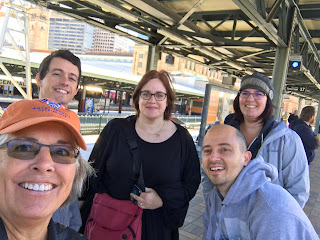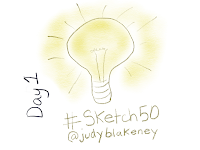BlakeneyBits
A blog exploring learning, leading, teaching, and tech.
Monday, January 13, 2025
Inspiration to Create: Remix what Educators Share on Social Media
Friday, November 15, 2024
Adobe Express - Creativity for Students and Educators
Adobe Express - Creativity for Students and Educators
 |
| Title Slide of Blakeney's AI Image Generation with Adobe Express Presentation |
The expansion of Adobe Express and Adobe for Education over the past several years have brought innovation for students and educators of PK-12 schools and beyond. As a Career Technical Education and English Language Development teacher at a Title 1 Middle School in Orange County, California, I have had the pleasrue and amazement of seeing Adobe Express through the eyes and creativity of my students.
AI Generation Tools
Adobe Express has been upgraded significantly this year, with added AI capabilities, particularly with images. Students have generated images representing themselves using Adobe Express Templates and Guided Activities. My students, even those with limited English, enjoyed and were motivated to create images representing themselves as well as animals.
In addition to image generation of people and animals, other AI image generation options are Text Generation and background images. The image above, which I used for a title slide, was one of several generated with the prompt "green field, with orchard and sunrise including a sky with clouds." The image below represents a poster I created about the computer lab classroom where I work, which I've titled "The Lab" and created text that is filled with fall colored leaves and grass.
.png) |
| The Lab Poster - AI Generated Text and Image |
Adobe Classroom in Adobe Express Edu Version
For students and teachers who have access to the Adobe Express Educational Version, use of a Classroom feature has been really beneficial, like a gift that keeps on giving with update and enhancements already this school year. Classroom was launched at the beginning of this school year in the United States. Teachers can push out, evaluate, comment, and download assignments that student access. These are shown in a gallery to teachers, but recently Adobe added a gallery viewing and commenting option for students as well, which teachers can turn on with a toggle switch - see the bottom left of this image to see the toggle switch.
 |
Create an Assignment Panel in Adobe Express ClassroomsBonus Resource - Link to PresentationHere is a a link to a recent presentation on AI Image Generation in Adobe Express. I hope you can get started creating images yourself and with students! Happy Creating! Judy Blakeney |
Monday, July 24, 2023
Thinking About Creativity - Book Reflection on The Greatest Song by Kevin Griffin
Thinking About Creativity:
The Greatest Song: Spark Creativity, Ignite Your Career, and Transform Your Life
By Kevin Griffin
2. Practice Two: Filling the Well: This practice calls for doing things that refill rather than deplete you so that when creative expression is needed, you have something to offer. In the rules for filling the well, the fifth one states: " The more you learn, the bigger the return" (Griffin 77).
Sunday, July 9, 2023
Rethinking Student Learning - English and Beyond.
My summer work as a teacher marks a making, dreaming, and reworking of my learning plans for students in the upcoming school year. Last year was by far my most challenging--and in ways most successful--as far as student growth is concerned. Still, as a teacher in a Title 1 middle school, I left the year pondering how it could have been better...and most importantly how I can reach the reluctant students who did not grow. While the topic of "student learning loss" and the impacts of the COVID-19 pandemic have been very real to me--as I lived through this over the past three years with my students, I know something has to change in the way I teach, so that all students benefit.
The difference this summer it thinking about inspiring students to write about identity through personal narratives and essays, as recommended in Penny Kittle and Kelly Gallagher's book, 4 Essential Studies. My ELA7 team was already working with Book Clubs and Digital Compositions. Next year we want to expand our work to include more Poetry and Personal Essays.
I am also being inspired by Ghouldy Mohammad's work which Kittle and Gallagher reference. I am reading her book, Cultivating Genius and working to develop lessons and learning activities for my students that allow them to explore their identities and share with each other via digital publishing, audio recordings and more.
This exploration and path has been prompted by many things, including my participation in the #Merit22 program through the Krause Center for Innovation last year in the #KCISTEAM Leadership program this year. I want to help create and sustain a learning program where all students succeed and thrive beyond their and my greatest dreams. That has always been the case for me as a teacher. I am hoping this year will continue to build on this goal for my students
Sunday, August 19, 2018
Why Go For #GoogleEI? My answer is #StrengthBasedEDU
Applying for the #SYD17 Cohort
My application to become a Google Innovator began with the dream of supporting all students in developing a strength-based approach to education. My dream was to support student, like my own adopted son, who struggled and were frustrated in school. I wondered, what if school where all students discovered their own innate talents, then built those talents into lifelong strengths. See my Google Innovator video application below for a before picture of my innovation project!Pivoting my Project
 |
| #SYD17 Crew on A Day Trip, August 2017 |
 |
| Dr. Tricia Hyun and Judy Blakeney at SGVCUE Conference |
Monday, July 3, 2017
What's Hot at #ISTE17 - @FlipGrid
So how could you use Flipgrid in a classroom? Here are some ideas:
- Welcome message to students and responses with their introductions
- Answering a question about a text, experiment, or math problem
- Stating a claim with evidence, for other classmates to respond to
- Getting teachers to respond to a concern within a school
Thursday, March 30, 2017
Gone #sketch50 Wild!
 Have you heard about #sketch50 (website https://sketch50.org/ ), where educators are creating
sketches using either digital or analog means to build skills at representing
ideas. Check out the description of this challenge on the website or Twitter
handle @sketch_50 and hashtag #sketch50.
Have you heard about #sketch50 (website https://sketch50.org/ ), where educators are creating
sketches using either digital or analog means to build skills at representing
ideas. Check out the description of this challenge on the website or Twitter
handle @sketch_50 and hashtag #sketch50.




